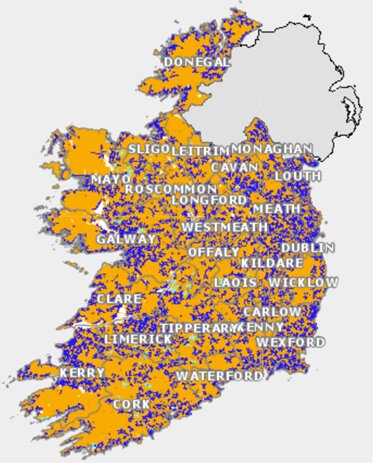Ireland provides a leading example of a national broadband plan that others are likely to follow
The National Broadband Plan (NBP) is a landmark project in Ireland and has been described as the most important piece of infrastructure since Irish rural electrification. It has the potential to significantly change the lives of many people and will ensure that 100% of the Irish population has access to high-speed broadband; an achievement that few countries have been able to accomplish. The COVID-19 crisis had yet to emerge when the Irish government signed the contract with National Broadband Ireland and claimed that access to high-speed broadband opens up “…opportunities in flexible and remote working, smart health with online GP and nursing services and medical monitoring, cloud-based services and connected devices, smart farming opportunities, digital learning, reliable electronic payments and booking”. Ireland and much of the world has since gone through a crash course in e-commerce, e-education, e-health, video communications, digital payments and remote working, thereby demonstrating the need for high-quality broadband services.
The Irish government awarded the 25-year contract to National Broadband Ireland to build the new rural network covering 540 000 premises in November 2019, after an extensive tender process. The network will provide fibre to the premises (FTTP) connectivity in the vast majority of cases, with provision for wireless alternatives for up to 2% of the hardest-to-reach premises. Nearly 300 broadband connection points (BCPs) will be provided in the first year of the project in order to support free Wi-Fi in local communities and digital work hubs in every county. The provision of the fibre network will take place alongside the roll out of these BCPs; 115 000 premises will be covered by the second year of the project and an additional 70 000–100 000 premises will be covered each year thereafter.
The Irish government had the foresight and courage to mandate universal coverage, thereby guaranteeing that rural communities would not be left behind and would instead have the same high-speed-broadband-enabled opportunities as those in urban areas. It was possible to forecast many of the benefits of the NBP, but the impact of the COVID-19 crisis is demonstrating just how tangible and immediate these are. Indeed, any doubts about governments using public funds to meet the significant costs of enhancing high-speed broadband coverage in their countries can now be more easily dispelled.
High-speed broadband access is proving to be an important utility that is necessary for the social and economic well-being of the world. This is highlighted by the current COVID-19 crisis: many businesses have worked remotely for the first time and have experimented with video calls, and thousands of teachers have delivered classes over broadband. 100% broadband coverage using robust networks will help to deliver universal services and further drive the adoption of new ways of working.
The design of the Irish NBP was complex
The Irish NBP was conceived in 2012, with a vision to permanently address the growing ‘digital divide’ in Ireland. The development of the plan was complex and challenging, but other governments and stakeholders can learn from it and carry out their own strategies more quickly.
Analysys Mason was a key advisor to the Irish government as the scheme was designed and developed. We worked with industry, the government, regulators and other stakeholders to develop the technical strategy and approach. This included evaluating and costing alternative technology solutions, specifying products (and how they would be futureproofed and evolve with market needs), determining the intervention area (see Figure 1) and defining deployment milestones and the mechanisms for benchmarking, product pricing, testing and verification and technical change control.
Figure 1: Map of the intervention area (amber) for the NBP

Source: DCCAE, 2019
Major parts of the project included:
- defining the technical strategy (including the minimum technical requirements, the approach to deployment, operations requirements and how the NBP will evolve and continue to meet the high-speed broadband needs of rural Ireland over the 25-year contract duration)
- documenting procurement requirements
- extensively engaging with bidders
- supporting the bidder selection process
- defining the intervention area, taking account of market developments
- engaging with national and EU stakeholders to ensure compliance with national guidelines, policies and rules.
Future broadband interventions should be easier
Projects such as the NBP need champions and the political will to look to the long term. Governments in some countries (including several that have implemented highly successful state interventions) have not pursued ubiquitous high-speed broadband in the past due to the considerable challenges involved in covering rural areas. The Irish government has not shied away from these challenges and will now see the benefits of its conviction. Others can learn from Ireland, and we expect that they should now be able do things more quickly, especially as the environment post-COVID-19 will be more supportive.
We expect to see more initiatives like the Irish NBP in the future given the current global crisis and the renewed appreciation of the benefits of high-speed broadband. We expect that policy makers will put more focus and resources into ubiquitous, robust networks in order to underpin their economy in normal times and be much better prepared in times of crisis, which could return. However, there are still difficult issues to address and Analysys Mason is well-placed to assist with these. We all share the objective of making access to broadband central to the future of economies, thereby making them more resilient and robust. However, it makes sense to start now and get all countries (and their economies) ready for the next challenge given that these network deployments are major engineering projects that require complex co-ordination.
For more information about the challenges involved in national high-speed broadband deployments and how these can be overcome efficiently, please contact Pat Kidney, Matt Yardley or Ian Adkins.
Article (PDF)
DownloadAuthor

Patrick Kidney
PartnerRelated items
Predictions
GPUaaS revenue will quadruple in the next 5 years, powering new data-centre investment opportunities
Predictions
Regulatory policy will demand a pivot from higher speeds to network coverage and resilience
Predictions
AI adoption is surging, but <25% of portfolio companies’ AI tools will fully succeed in 2026

